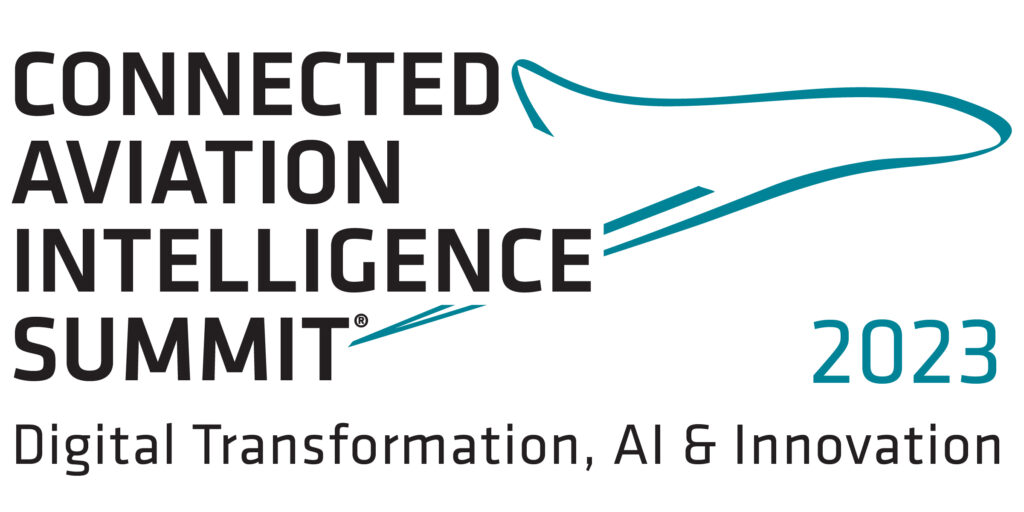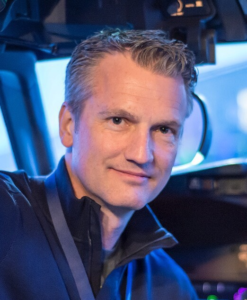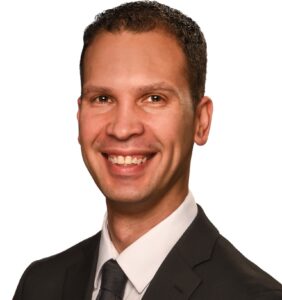2023 Agenda
Wednesday, September 6th
- 8:00 am — 9:00 am
Networking Breakfast
- 9:00 am — 9:30 am
Opening Keynote: AI Accelerates Transformation in Aviation
We have known for years that AI is a transformative force for business. As 2023 set in, the emergence of Generative AI through ChatGPT took us by surprise. It made evident that the pace and depth of this transformation will be greater than we anticipated. Recent research by leading consulting firms and universities affirms that Generative AI will reshape work for every single knowledge worker. In this talk we will explore the potential for AI to transform our businesses, highlighting the benefit of real-time data enabled by connectivity.
- 9:30 am — 10:00 am
Converging Tech and its Impact on Sustainable Aviation
The combination of previously independent, rapidly improving new technologies, including but not limited to the latest advancements in connectivity, is already beginning to transform the aviation industry. The pace of these developments is accelerating. As they converge with each other, the result is potential or purposeful exponential change. Join this session to learn what some of these converging technologies are in aviation, their relationship with megatrends like sustainability, and where you might participate in the upside and avoid being left behind.
- 10:00 am — 10:30 am
Onboard Intelligence and the New Horizon of Observability
The inability to access, capture, analyze, and interpret all the data generated by systems onboard aircraft comprehensively is a challenge for most operators today. This limitation hinders the detection of critical issues such as maintenance problems, cybersecurity threats, and compliance concerns. Without critical, data-driven insights into what’s happening onboard your aircraft, you may be left vulnerable while struggling to make well-informed decisions that can help ensure the operational efficiency and increased safety of your fleet. This ongoing challenge underscores the need for innovative solutions to improve observability across your entire fleet.
Join us for a discussion about what observability entails and what it enables. We’ll explore how the data created by onboard systems can be captured and analyzed to help you improve the resiliency of airline operations and the efficiency and longevity of your aircraft. In this session, you’ll learn the following:
- Why gaining observability into onboard systems is so difficult today.
- How a lack of observability today increases cybersecurity risks, potentially impacting operational resilience.
- What role onboard serial data plays in providing better observability across your fleet.
- 10:30 am — 11:00 am
Networking Break
- 11:00 am — 11:45 am
The Connected Future: Exploring the Next Stage of Connectivity in Airlines, Predictive Maintenance, and Enhanced Operations
It is clear that airlines are using connectivity more and more to impact their operations as well as to boost the passenger experience. From better maintenance and fuel efficiency to better communication between staff, the benefits are all-encompassing. However, as more bandwidth becomes available, and more software and apps are developed, what is the next stage for this? Here we talk about apps, predictive maintenance, and how the “connected” operation of an aircraft may look in the future.
 Bobby AndersonVice President/General Manager for Commercial AviationShift5 Inc
Bobby AndersonVice President/General Manager for Commercial AviationShift5 Inc Kim BlakelySenior Manager, Flight Operations, CNS Pgm and TechUnited Airlines
Kim BlakelySenior Manager, Flight Operations, CNS Pgm and TechUnited Airlines Mark CanadaPartnerDialexa (an IBM Company)
Mark CanadaPartnerDialexa (an IBM Company) Nate HicksVice President, Product ManagementGE Digital
Nate HicksVice President, Product ManagementGE Digital Bret PeytonManaging Director Standards, Fleet & Operational ControlAlaska Airlines
Bret PeytonManaging Director Standards, Fleet & Operational ControlAlaska Airlines Dan ParsonsAssociate EditorAvionics InternationalModerator
Dan ParsonsAssociate EditorAvionics InternationalModerator - 11:45 am — 12:15 pm
Exploring the Balancing Act: Integrating Connectivity and Security in Aviation Operations
With the increasing affordability of connectivity and advancements in technology, we now possess a greater array of possibilities for integrating connectivity into various aspects. Often, this integration is motivated by improved operational effectiveness. However, it’s crucial to strike a harmony between these operational requirements and the imperative of maintaining the security of aircraft. Tune in to Andrew’s discussion as he explores factors to contemplate regarding the well-being of crew, passengers, and maintenance processes.
- 12:30 pm — 2:00 pm
Networking Luncheon
- 2:00 pm — 2:30 pm
Leading the Way in IFC Services and Introducing the Vision of a 'Connected' Aircraft
Air Canada is one of the pioneers when it comes to offering IFC services. It is one of North America’s major airlines and it has exciting plans for the future as it looks to offer the next generation of services based on a ‘Connected’ aircraft. We’ll talk to Norm Haughton, Air Canada’s Director, In-Flight Digital Entertainment, Wi-Fi, Media Sales and Analytics about how these plans are taking shape.
- 2:30 pm — 3:00 pm
Make Machine-Learning and Predictive Maintenance Part of Your Daily Operation
Make machine-learning and predictive maintenance part of your daily operation, without the need for a data scientist. Discover key-elements to make data-informed maintenance part of your daily operation. Leverage built-in Augmented Analytics tools that use machine learning to deliver insights for effective predictive maintenance. Engineer or analyst roles can easily develop predictive maintenance algorithms, relying on AI to integrate and analyze maintenance data and plan for future component failure and avoid unscheduled events. With the right process and solutions, you don’t need to be a data scientist to benefit from data science capabilities.
- 3:00 pm — 3:45 pm
Unleashing the Potential: Exploring the Impact of AI/ML Technologies in the Aviation Industry
The use of AI/ML in aviation is not new; the industry has seen predictive arrival times, departure times, delays, overbookings. Now with the latest buzz in the technology world around Chat GPT, Baird, and others – the use of artificial intelligence and machine learning in EVERYTHING has become a great conversation in every industry. It brings up this important question – How can all the new AI/ML technologies improve the aviation industry? Is there a specific area that we think would benefit the industry the most? Are you using ML/AI today? If so, How are you using ML within your aviation business? If you aren’t, do you want to?
- 3:45 pm — 4:15 pm
Networking Break
- 4:15 pm — 5:00 pm
The Connected Skies: Unveiling the Distinct Approaches of Bizjet Operators Towards Connectivity and Sustainability in Comparison to Commercial Airlines
Bizjet operators are a key part of the “connected ecosystem.” They have high wealth customers who expect connectivity. However, do their approaches differ from commercial airlines? This panel looks at this part of the market and their drive to sustainability as well as whether their approaches to connectivity and sustainability differ from their commercial counterparts.
 Natalia Vargas BejaranoDirector, Aftermarket Product and Digital Strategy & PMOBombardier
Natalia Vargas BejaranoDirector, Aftermarket Product and Digital Strategy & PMOBombardier Andrew DrakeManager, Aviation CybersecurityNetJets
Andrew DrakeManager, Aviation CybersecurityNetJets Sean ReillyVice President, Air Transport Management & Digital SolutionsSmartSky Networks
Sean ReillyVice President, Air Transport Management & Digital SolutionsSmartSky Networks Ray RennertNew Product Development Program ManagerGulfstream Aerospace
Ray RennertNew Product Development Program ManagerGulfstream Aerospace Jessica ReedEditorAvionics MagazineModerator
Jessica ReedEditorAvionics MagazineModerator - 5:00 pm — 5:30 pm
How to Implement Cybersecurity Measures in a Complex Industry
Cybersecurity incidents in aviation are on the rise, but detailed information and measures taken often remain undisclosed due to the industry’s closed-off nature. The aviation sector’s complex and slow-to-respond nature makes implementing comprehensive solutions seem challenging, contributing to a lack of proactive cybersecurity measures. Although some positive changes, like evolving regulations and industry compliance, are emerging, they fall short of addressing the issue adequately. To enhance cybersecurity, a gradual approach involving knowledge sharing, awareness initiatives, training, and risk assessments can collectively contribute to building cyber resilience in the aviation industry.
- 5:30 pm — 6:30 pm
The 10th Annual Connected Aviation Welcome Reception
Thursday, September 7th
- 8:30 am — 9:30 am
Networking Breakfast
- 9:30 am — 10:00 am
Keynote: Flying in the Face of Predictive Analytics: Making Sense of the Data Swamp
Welcome to securing an airplane. How hard can it be? VERY, so let’s talk about how we are approaching it differently, how we are building a proactive, self-healing, intelligent, aware, and sustainable platform that addresses today’s aviation safety and security challenges.
- 10:00 am — 10:45 am
Unlocking the Value of Passenger Connectivity: Exploring Innovative Approaches and Economics for Airlines in a Free Connectivity Model
While Day One of the Summit focused on issues of sustainability and better efficiency, it is clear that for airlines to justify these huge investments in connectivity, they will have to find innovative approaches on the customer side to make the ROI work. If they move to the “free” model, where passengers no longer have to pay for connectivity, where can they make a return? What are the economics of this, and can they still charge if a number of airlines move for free? This panel will talk about the economics of making passenger connectivity work.
 Norm HaughtonDirector, In-Flight Digital Entertainment, Wi-Fi, Media Sales & AnalyticsAir Canada
Norm HaughtonDirector, In-Flight Digital Entertainment, Wi-Fi, Media Sales & AnalyticsAir Canada Brittany McSweenySenior CX Connectivity ConsultantSouthwest Airlines
Brittany McSweenySenior CX Connectivity ConsultantSouthwest Airlines Daniela RamosHead of On Board Sales and Service, In-Flight Entertainment & Global CateringVolaris
Daniela RamosHead of On Board Sales and Service, In-Flight Entertainment & Global CateringVolaris Angela VargoHead of Brand MarketingBreeze Airways
Angela VargoHead of Brand MarketingBreeze Airways Mark HolmesSenior Editorial DirectorVia SatelliteModerator
Mark HolmesSenior Editorial DirectorVia SatelliteModerator - 10:45 am — 11:15 am
Networking Break
- 11:15 am — 12:00 pm
Market Insights Unveiled: Analysts and Influencers Discuss Trends, Forecasts, and Outlook for the Future of the Airline Industry
In an exciting panel discussion, prominent analysts from major firms share their valuable insights and market forecasts. They delve into emerging trends, evaluating their potential impact, and express their perspectives on the future outlook of the market. Joined by key influencers, this dynamic conversation aims to align their visions with the perspectives we have gathered from airlines, creating a comprehensive understanding of the market’s trajectory.
 Glen AllmendingerFounder and PresidentHarbor Research
Glen AllmendingerFounder and PresidentHarbor Research Daniel Intolubbe-ChmilSenior ConsultantHarbor Research
Daniel Intolubbe-ChmilSenior ConsultantHarbor Research Brent ProkoshSenior ConsultantEuroconsult
Brent ProkoshSenior ConsultantEuroconsult Mary RogozinskiDirector of Business Development - Aviation, TransportationNetForecast, Inc.
Mary RogozinskiDirector of Business Development - Aviation, TransportationNetForecast, Inc. Dan ParsonsAssociate EditorAvionics InternationalModerator
Dan ParsonsAssociate EditorAvionics InternationalModerator - 12:00 pm — 12:30 pm
How to Make Advanced Air Mobility Affordable to Achieve Large Sustainability Wins
Advanced Air Mobility is green with batteries and in the future hydrogen driven drones and VTOL. However, if we can’t build cost efficient infrastructure it may risk only replacing expensive flight options (e.g. helicopters, regional flights etc) and not ground transport (e.g. cars, trucks etc). How is Kookiejar addressing this challenge?
- 12:30 pm — 2:00 pm
Networking Luncheon
- 2:00 pm — 2:45 pm
Exploring the Rise of LEO Satellites: Assessing the Economic Potential and Impact on Aviation
Another year passes, and another year where satellites in Low Earth Orbit (LEO) become the mainstream. The economics of LEO on paper look compelling. While GEO satellites will still have a role to play, and we will see some big GEO launches over the next few years, it means airlines have more choice than ever on which to base their connectivity services. Here, we examine the latest in satellites, and talk about LEO/MEO/GEO, and how the ‘LEO revolution’ could impact aviation.
- 2:45 pm — 3:30 pm
Beyond Connectivity: Exploring the Future of Satellite Industry in Aviation - Integration, Innovation, and Market Expansion
The satellite industry is more than just LEO. There are questions over the overall costs, terminals, software, integration between satellite and cloud, as well as other orbits other than LEO. Many satellite players see aviation as one of their key markets and airlines are keen to work with players here. But, as players consolidate (Intelsat/Gogo, Viasat/Inmarsat) what can satellite players offer in the future beyond just connectivity.
 Paul FreudSatcom User Terminal ProductsBall Aerospace
Paul FreudSatcom User Terminal ProductsBall Aerospace Daniel GizinskiChief Strategy OfficerComtech Telecommunications Corp
Daniel GizinskiChief Strategy OfficerComtech Telecommunications Corp Steve NewellVice President of AviationESpace Networks
Steve NewellVice President of AviationESpace Networks John PetersonExecutive Director of AviationIridium Communications
John PetersonExecutive Director of AviationIridium Communications Mark HolmesSenior Editorial DirectorVia SatelliteModerator
Mark HolmesSenior Editorial DirectorVia SatelliteModerator - 3:30 pm — 4:00 pm
Networking Break
- 4:00 pm — 5:15 pm
Driving Success in Aviation: Seamless Air Alliance Returns to Address Key Industry Challenges and Empower Airlines
The Seamless Air Alliance plays a vital role in fostering communications and dialogue between the airlines and the industry. After a successful panel in 2022, we welcome them back to talk about the key issues of the day and what the Alliance can do to help airlines be successful in these areas.
 Brian KirbySenior Technical Product ManagerTelesat
Brian KirbySenior Technical Product ManagerTelesat Peter LemmeChief ConsultantSeamless Air Alliance
Peter LemmeChief ConsultantSeamless Air Alliance Thomas LockeChief Technology OfficerGlobalReach Technologies
Thomas LockeChief Technology OfficerGlobalReach Technologies Mark NashHead of Commercial RoamingPanasonic Avionics Corporation
Mark NashHead of Commercial RoamingPanasonic Avionics Corporation André PatrickManager, In-Flight Wi-Fi & AnalyticsAir Canada
André PatrickManager, In-Flight Wi-Fi & AnalyticsAir Canada Sean YarboroughVice President, Product ManagementST Engineering iDirect, Inc.
Sean YarboroughVice President, Product ManagementST Engineering iDirect, Inc. Jack MandalaChief Executive OfficerSeamless Air AllianceModerator
Jack MandalaChief Executive OfficerSeamless Air AllianceModerator - 5:15 pm — 6:30 pm
A Taste of Colorado Happy Hour
Please join us in the exhibit hall for an evening of networking while enjoying Colorado’s local favorites!
Friday, September 8th
- 8:00 am — 9:00 am
Networking Breakfast
- 9:00 am — 9:45 am
Keynote Address: Are We Shifting Left Enough?
FAA emerging strategies to identify and resolve cyber vulnerabilities early in the development cycle.
- 9:45 am — 10:15 am
Sustainability, Connectivity, AI, and More: A Dialogue with SAS
Jasmin Utter, General Manager Region Americas of SAS, talks about the airline’s sustainability efforts in this dialogue session with moderator Jessica Reed. She also discusses the potential of AI and satellite technologies in addition to the utilization of data from onboard systems for operational efficiency.
- 10:15 am — 10:45 am
Connected Operations, Training/Simulation, and Smart Aircraft
The avionics, including the FMS, are isolated from the world for safety and certification purposes. GE Aerospace aims to offer the key to improving the pilot experience and taking advantage of the EFB by:
- Putting the identical FMS from the aircraft onto the EFB for training, with free play and scenario-based training providing relief to overloaded certified simulators; and
- Providing a secure, two-way connection between the EFB and FMS, allowing for the exchange of data such as flight plans and position, reducing manual entries in the cockpit. A Diversion Assistant application using this connection can also reduce workload in emergency situations.
- 10:45 am — 11:15 am
Networking Break
- 11:15 am — 12:00 pm
Securing the Skies: Cyber Experts Unveil Emerging Threat Trends and Strategies for Safeguarding Aviation Data
In a first for the Connected Aviation Summit, key cyber experts discuss the major trends they are seeing on the threat landscape. Experts will address the threat vectors and aviation data security, and how the landscape is shifting and changing, and what trends in the cyber world, the aviation industry should be looking out for.
- 12:00 pm — 12:00 pm
Conference Ends






















































